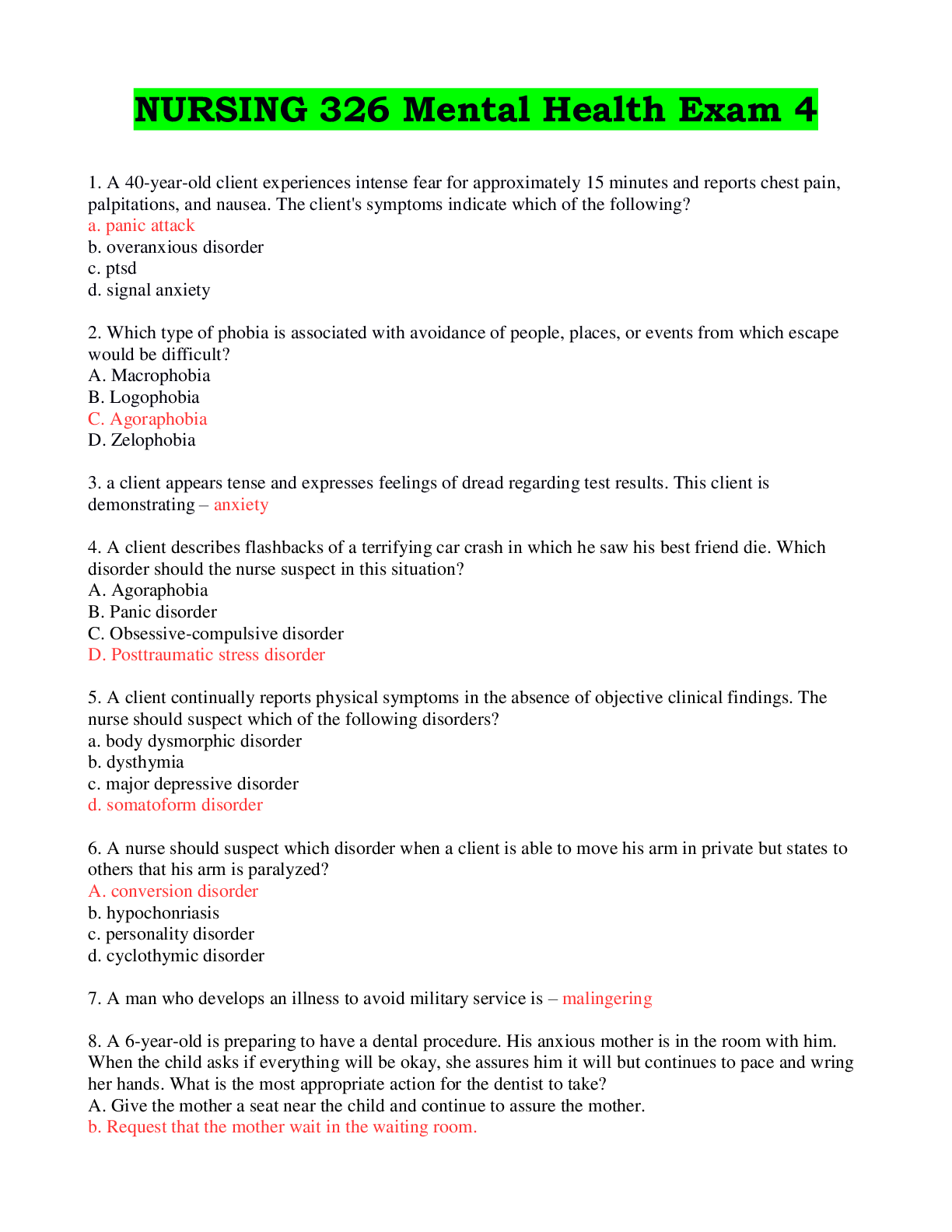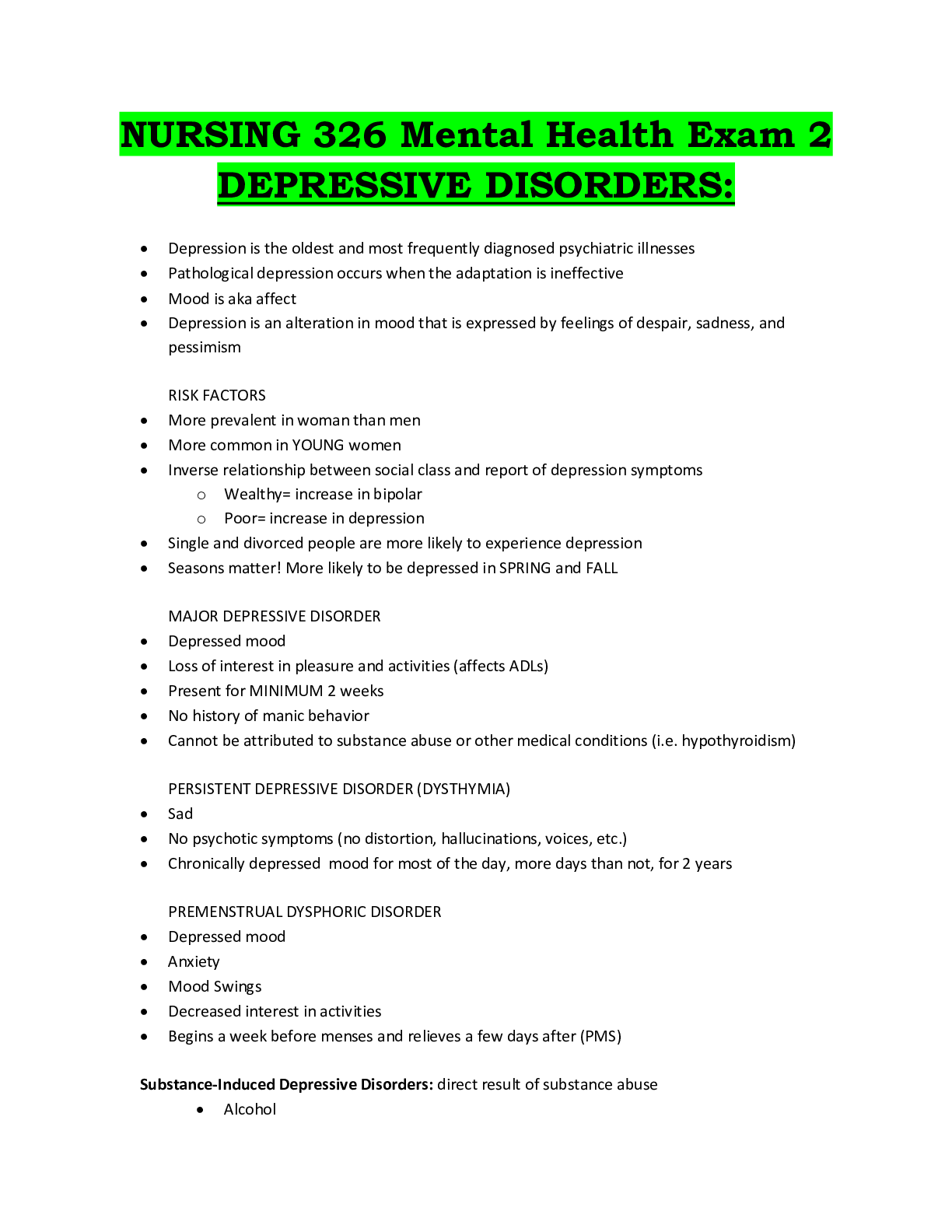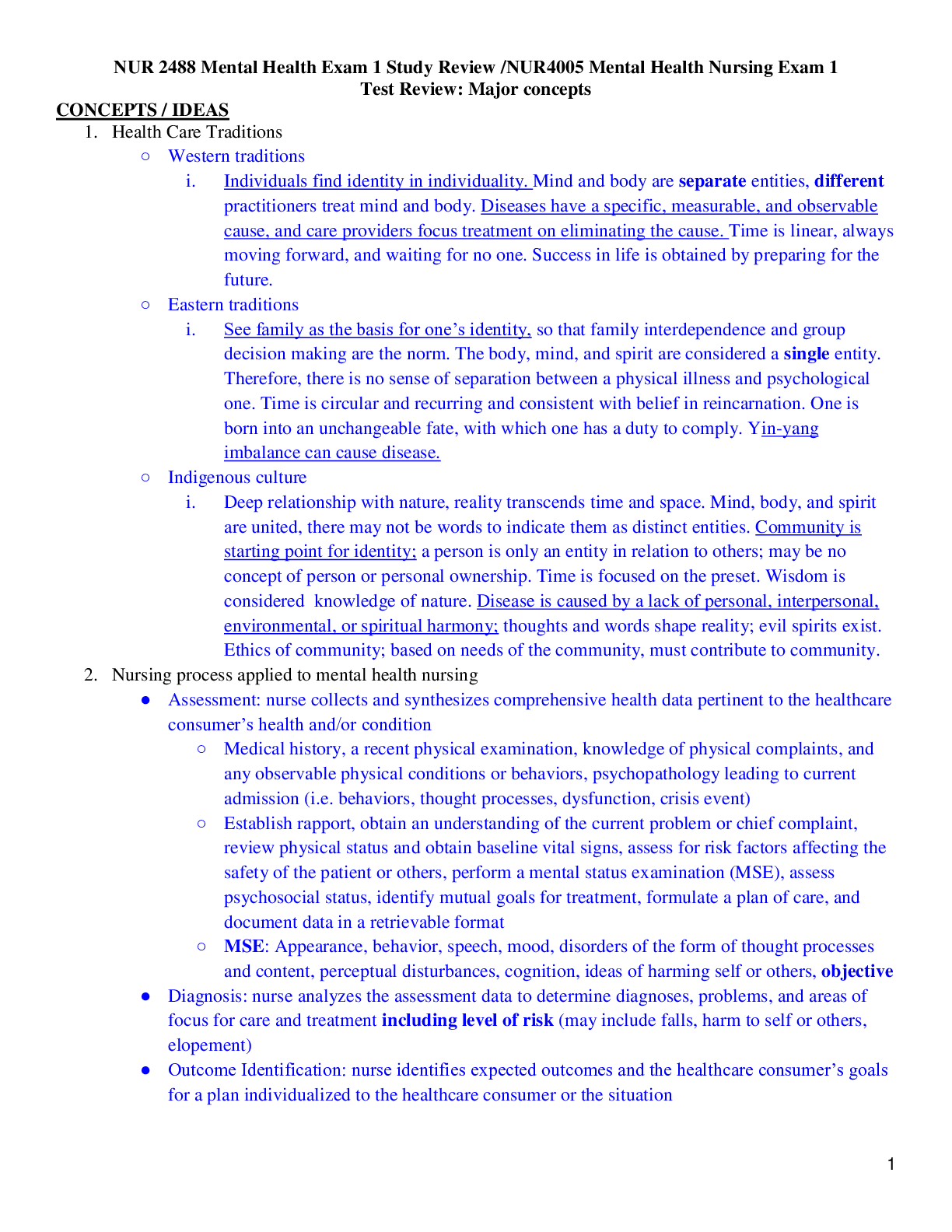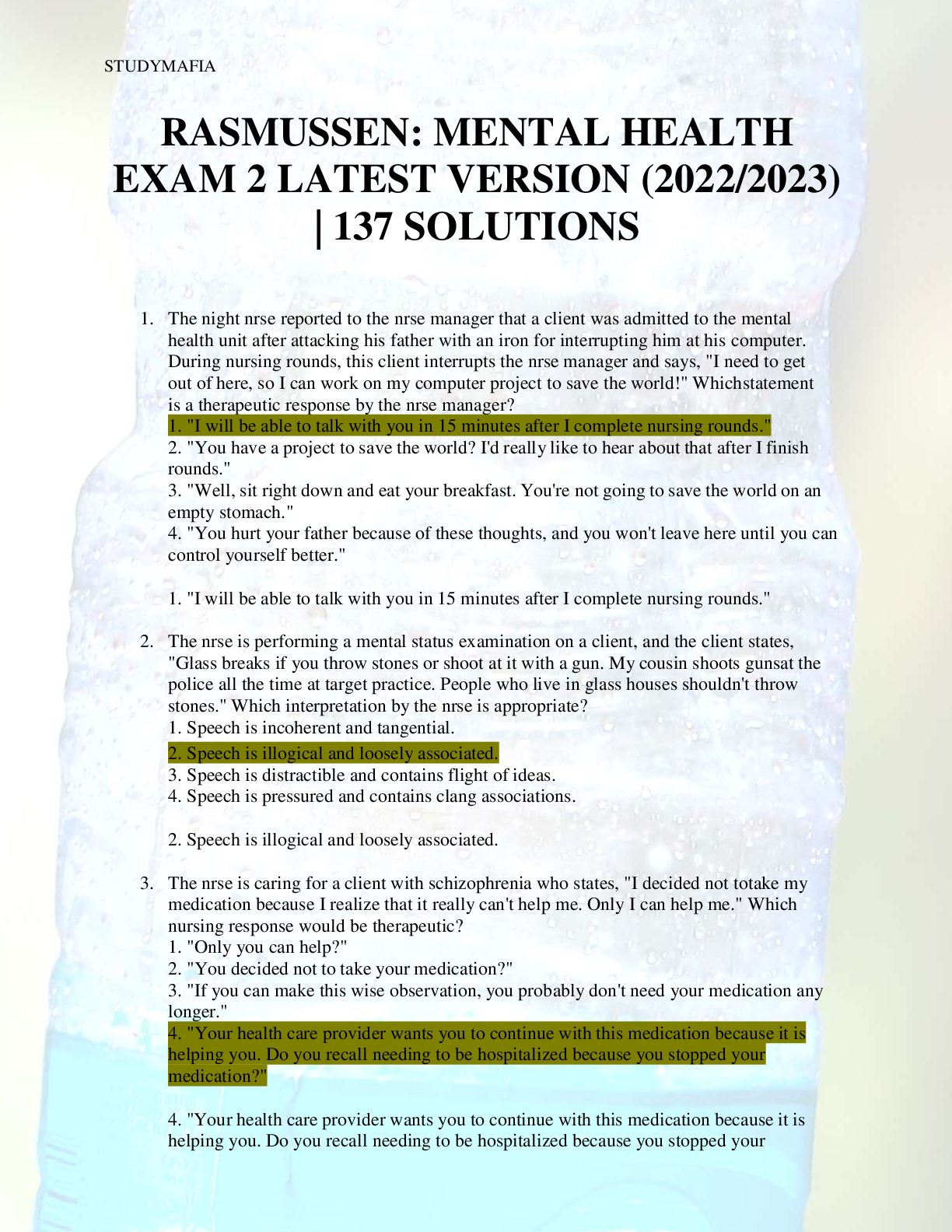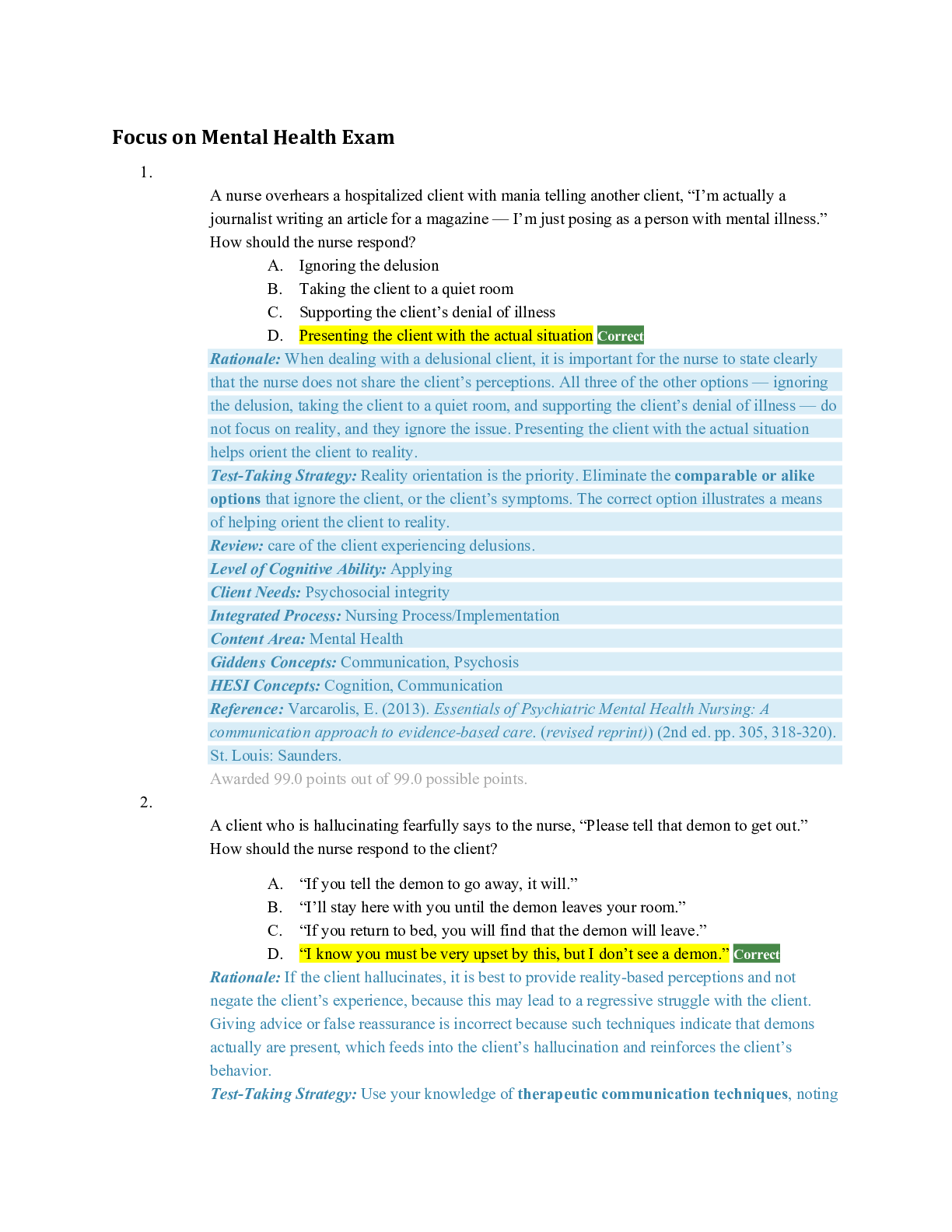*NURSING > EXAM REVIEW > NURSING 326 Mental Health Exam 1: for Grade A with Answers... (All)
NURSING 326 Mental Health Exam 1: for Grade A with Answers...
Document Content and Description Below
NURSING 326 Mental Health Exam 1: Chapter 1: • Stress: the state manifested by a specific syndrome that consists of all the nonspecifically induced changes within a biological system. Part of ... the ‘fight-or-flight’ system. • Seyle’s General Adaptation System: -Alarm reaction stage (brief) -Stage of Resistance (management) -Stage of exhaustion (manifestation) • Measured by the Miller and Rahe Recent Life Changes Questionnaire o Does not consider individual’s perception of the event o Does not take into account coping strategies or support systems • The definition of stress emphasizes the relationship between the individual and the environment which is appraised by the individual as taxing or exceeding his or her resources and endangering his or her well being • Precipitating Event: A stimulus arising from the internal or external environment and perceived by the individual in a specific manner • Perception of the Event: o Primary appraisal: a judgment about the situation in an irrelevant, benign-positive, or stress appraisal way o Secondary appraisal: an assessment of the skills, resources, and knowledge that the person possesses to deal with the situation Chapter 2: • Benjamin Rush: “father” of psychology • Dorothea Dix: activist successful in the lobbying for the establishment of state hospitals for individuals with mental illness • Linda Richards: FIRST American psychiatric nurse o Helped establish the first school of psychiatric nursing at the McLean Asylum in Waverly, MA (1882) • Mental Health: successful adaptation to stressors from the internal or external environment, evidenced by thoughts, feelings, and behaviors that are age appropriate and congruent with local and cultural norms • Mental Illness: maladaptive responses to stressors from the internal or external environment, evidenced by thoughts, feelings, and behaviors that are incongruent with the local and cultural norms and interfere with the individuals social occupational or physical functioning. • **Cultural Influences** o Incomprehensibility: the inability of the general population to understand the motivation behind a behavior o Cultural Relativity: the ‘normality’ of a behavior is determined by the culture **Anxiety and grief are two major primary psychological response patterns to stress** • Anxiety: a diffuse apprehension that is vague in nature and is associated with feelings of uncertainty and helplessness • Hildegard Peplau’s Four Levels of Anxiety: o Mild: Seldom a problem o Moderate: perceptual field diminishes o Severe: perceptual fear is so diminished that concentration is centered around one detail only, or many extraneous details o Panic: most intense state • Functioning and the moderate to severe level of anxiety can cause migraines, IBS, and cardiac arrhythmias • Repressed severe anxiety can result in anxiety disorders, somatic symptom disorders and dissociative disorders • Extended periods of functioning at the panic level can cause psychosis and psychotic behavior **Kubler-Ross’s 5 Stages of Grief” 1. Denial 2. Anger 3. Bargaining 4. Depression 5. Acceptance • Anticipatory Grief: the experience of the grieving process before the actual loss occurs • Resolution: The length of the grief process is entirely individual. Can last from a few weeks to years and is influenced by a number of factors **Resolution of the grief response is thought to occur when an individual can look back on the relationship with the lost entity and accept both the pleasures and the disappointments of the association Chapter 3: Personality is defined as the characteristic way in which a person think, feels, and behaves; the ingrained pattern of behavior that each person evolves, both consciously and unconsciously, as his or her style of life or way of being. • Stages are identified by age but influenced by temperament • Personality disorders occur when personality traits become inflexible and personality functioning becomes individually and interpersonally impaired • Freud o Basic character was formed by 5 years old o 3 major components: ID EGO SUPEREGO • Dynamics of Personality: Freud o Psychic Energy o Cathexis o Anticathixis • Development of the Personality: Freud o Oral Stage (birth to 18 months) o Anal Stage (18 months to 3 years) o Phallic Stage (3 to 6 years) o Latency Stage (6 to 12 years) o Genital Stage (13 to 20 years) • Interpersonal Theory: Sullivan- based on the belief that the individual behavior and personality development are the direct result of interpersonal relationships o Infancy (birth to 18 months) o Childhood (18 months to 6 years) o Juvenile (6 to 9 years) o Preadolescence ( 9 to 12 years) o Early Adolescence (12 to 14 years) o Late Adolescence (14 to 21 years) • Theory of Psychosocial Development: Erikson o Trust v Mistrust (birth to 18 months) o Autonomy v Shame and Doubt (18 months to 3 years) o Initiative v Guilt (3 to 6 years) o Industry v Inferiority ( 6 to 12 years) o Identity v Role Confusion (12 to 20 years) o Intimacy v Isolation (20 to 30 years) o Generativity v Stagnation (30 to 65 years) o Ego Integrity v Despair (65 years to death) • Theory of Object Relations: Mahler- Based on the separation individual process of the infant from the maternal figure (primary caregiver) o Phase I: Autism (birth to 1 month) o Phase II: Symbiosis (1 to 5 months) o Phase III: Separation-Individuation (5 to 36 months) Differentiation (5 to 10 months) Practicing (10 to 16 months) Rapprochement (16 to 24 months) Consolidation (24 to 36 months) ** The emotional problems of many individuals can be traced to lack of fulfillment of the tasks of separation-individuation • Theory of Moral Development: Kohlberg- Stages of moral development are tied to individual’s motivation behind the behavior o Preconventional Level (4-10 years) o Conventional Level (10-13 years and into adulthood) o Postconventional Level (from adolescence on) • Nursing Model of Interpersonal Development: Peplau o Stranger - in the beginning nurse and patient are strangers o Resource Person – the nurse provides information related to the client’s health care o Counselor – the nurse uses interpersonal techniques to help client’s learn to adapt to difficulties or changes in life experiences o Teacher – the nurse identifies learning needs and provides education to improve the health situation o Leader – allows the client to be an active participant in his or her care o Technical Expert – the nurse possesses the clinical skills necessary to perform the interventions that are in the client’s best interest o Surrogate – for the client, the nurse fulfills basic needs which is associated with mothering • Four Stages of Personality Development: Peplau o Stage 1: Learning to count on others o Stage 2: Learning to delay gratification o Stage 3: Identifying Oneself o Stage 4: Developing skills in participation Chapter 4: • The “limbic” system is the emotional brain and can help stabilize emotional behavior • Antipsychotics are to be used as an adjunct to individual or group therapy • Most action occurs at the neuronal synapse • Antidepressants block reuptake of Serotonin and Nor epinephrine (SSRI) • Antipsychotics work by blocking specific neurotransmitter receptors • Benzodiazepines facilitate the transmission of GABA Chapter 5: Right: is a valid, legally recognized claim or entitlement encompassing both freedom from government interference or discriminatory treatment and entitlement to a benefit or service Absolute Right: when there is no restriction whatsoever on the individual’s entitlement Legal Right: is a right on which the society has agreed and formalized into law 5 Ethical Principles • Autonomy • Beneficence • Nonmaleficence • Justice • Fidelity/Veracity • Ethical Issues in Psych: o The right to refuse medication o The right to the least restrictive treatment alternative • The Nurse Practice Act: Defines the scope of practice for nurses Chapter 7: • A therapeutic relationship is an interaction between two people (usually a caregiver and care receiver) in which input from both participants contributes to a climate of healing, growth promotion, and illness prevention • Peplau believe that the emphasis in psychiatric nursing should be on the counseling subrole • Therapeutic Use of Self: The ability to use one’s personality consciously and in full awareness in an attempt to establish relatedness and to structure nursing interventions • The Johari Window: representation of the self and a tool that can be used to increase self-awareness o The open or public self o The unknowing self o The unknown self o The private self • Conditions Essential to Development of a Therapeutic Relationship: o Rapport o Trust o Respect o Genuineness o Empathy • Phases of the Therapeutic Relationship o Preinteraction Phase o Orientation Phase o Working Phase Transference Countertransference o Termination Phase • Remember to keep boundaries with patient Chapter 8: • Preexisting conditions affect communication and treatment. Things such as: o Gender o Social Status o Values, attitudes, beliefs o Culture/ Religion o Age and Developmental Level • Therapeutic Communication Techniques: o Using silence o Accepting o Giving recognition o Offering self o Giving broad openings o Offering general leads o Placing the event in time or sequence o Making observations o Encouraging descriptions of perceptions o Encouraging comparison o Restating o Reflecting o Focusing o Exploring o Seeking clarification and validation o Presenting reality o Voicing doubt o Verbalizing the implied o Attempting to translate words into feelings o Formulating a plan of action • Nontherapeutic Communication Techniques o Giving reassurance o Rejecting o Giving approval or disapproval o Agreeing/disagreeing o Giving advice o Probing o Defending o Requesting an explanation o Indicating then existence of an external source of power o Belittling feelings expressed o Making stereotyped comments o Using denial o Interpreting o Introducing unrelated topics **Active Listening Sit facing the client Observe an open posture Lean towards client Establish eye contact Relax Chapter 9: **The nursing process in Psychiatric Nursing: • Assessment • Diagnosis • Outcomes Identification o NOC- Nursing Outcomes Classification • Planning o Nursing Interventions Classification • Implementation APIE: Assessment, Problem, Intervention, Evaluation Chapter 10: Therapeutic Groups v. Group Therapy: • Group Therapy: has a sound theoretical base and leaders generally have advanced degrees in psychology, social work, nursing, or medicine • Therapeutic Groups: based to a lesser extent on theory; focus is on group relations, interactions, between group members, and the consideration of a selected issue • Self-Help Groups: Composed of individuals with similar problems (i.e. AA, NA) • Curative Factors of Groups o Instillation of Hope o Universality o Imparting of Information (education) o Altruism- assistance and support to each other o Corrective Recapitulation of the Primary Family Group o Development of Socializing Techniques o Imitative Behavior o Interpersonal Learning o Group Cohesiveness o Catharsis o Existential Factors Chapter 12: Milieu Therapy: therapeutic community- a scientific structuring of the environment to effect behavioral changes and to improve the psychological health and functioning of the individual • Every interaction is an opportunity for therapeutic interventions • The client owns his or her environment and his or her own behavior • Inappropriate behaviors are dealt with as they occur • Restrictions and punishment are to be avoided Chapter 13: • Any stressful situation can precipitate a crisis • Crisis: any sudden event in one’s life that disturbs homeostasis during which usual coping mechanisms cannot resolve the problem • Response to a crisis depends on three factors: 1. The individual’s perception of the event 2. The availability of situational support 3. The availability of adequate coping mechanisms • Dispositional Crisis: an acute response to an external situational stressor • Crises of Anticipated Life Transitions: normal life-cycle transitions that may be anticipated but over which the individual may feel a lack of control • Crisis Resulting From Traumatic Stress: crisis precipitated by an unexpected external stressor over which the individual has little or no control and from which he or she feels emotionally overwhelmed and defeated • Maturational/ Developmental Crisis: crisis that occurs in response to a situation that triggers emotions related to unresolved conflicts in one’s life • Crisis Reflecting Psychopathology: emotional crisis of which preexisting psychopathology has been instrumental in precipitating or in which psychopathology significantly impairs or complicates adaptive resolution • Phases of the Crisis Intervention: o Phase 1: Assessment o Phase 2: Planning of Therapeutic Intervention o Phase 3: Intervention o Phase 4: Evaluation of Crisis Resolution and Anticipatory Planning Chapter 16: Aggression: one way that individuals express anger, can be emotional or physical. Is a behavior that is intended to threaten or injure the victim’s security or self esteem **Role modeling is one of the strongest forms of learning** • Operant Conditioning is when a specific behavior is learned by positive or negative reinforcement • Anger and aggression can be learned through operant conditioning • Predisposing Factors to anger and aggression: o Biochemical factors o Socioeconomic factors o Environmental factors • Anger can be identified with characteristics that include: o Frowning o Clenched Fists o Low-pitched words forced through clenched teeth o Yelling and shouting o Intense or no eye contact o Easily offended o Defensive o Passive-aggressive o Emotional overcontrol and flushed face o Intense discomfort o Tension • Aggression can be identified by: o Pacing o Restlessness o Tense face and body o Verbal or physical threats o Threats of homicide or suicide o Loud voice, shouting, use of obscenities o Argumentative o Increased agitation o Overreaction to environmental stimuli o Panic anxiety o Disturbed thought process o Suspiciousness o Disproportionate anger o Role model o Help find alternative ways of relieving tension Chapter 18: A behavior is considered to be maladaptive when it; is age inappropriate, interferes with adaptive functioning, is misunderstood by others in terms of cultural inappropriateness • Techniques for modifying behavior: o Shaping o Modeling o Contingency Contracting o Token Economy o Time Out o Flooding o Overt sensitization (medicine that makes you when you drink) Chapter 19: Cognitive Therapy is aimed at modifying distorted cognitions about a situation. The goal is for client’s to learn to identify and alter the dysfunctional beliefs that predispose them to distort experiences • Goal orientated and problem-focused • Emphasizes the present • Automatic thoughts: thoughts that occur rapidly in response to a situation and without rational analysis; sometimes called cognitive errors. o Arbitrary inference o Overgeneralization o Dichotomous thinking o Selective abstraction o Magnification o Minimization o Catastrophic thinking o Personalization • Schemas: Cognitive structures that develop early in life from personal experiences. These concepts are reinforced by further learning experiences and influence the formation of other beliefs, values, and attitudes. Schemas can be adaptive or maladaptive, general or specific, and positive or negative. • Clients must be prepared to become their own therapists • Assignments are done to reinforce learning Chapter 20: ECT is the induction of a grand mal seizure through the application of an electrical current to the brain; stimulus applied through electrodes • The duration of the seizure should be about 15 to 25 seconds • Usually administered every other day for about 6 to 12 treatments • Effective in the treatment of severe depression, growing popularity after the 80s o NOT considered a treatment of first choice • Also indicated in the treatment of acute manic episodes of bipolar and acute schizophrenia • Only contraindication is increased ICP • S/E include temporary memory loss and confusion, sometimes there is retrograde amnesia • Atropine sulfate or glycopyrrolate is administered 30 minutes before the treatment • VS q 15 minutes after procedure • Orient client to help with confusion Chapter 29: Somatic symptom disorders are characterized by physical symptoms suggesting medical disease but without demonstrable organic pathophysiological mechanism to account for them. Dissociative disorders are defined by a disruption in the usually integrated functions of consciousness, memory, and identity. • SSD’s have been identified as hysterical neuroses and were thought to be a response to repressed severe anxiety • SSD’s are more commonly found in: o Women o Less educated persons o Rural areas • Dissociative Disorders (DID) are rare. They are also more prevalent in women than in men • Drug abuse and dependence are common complications of SSD [Show More]
Last updated: 1 year ago
Preview 1 out of 5 pages
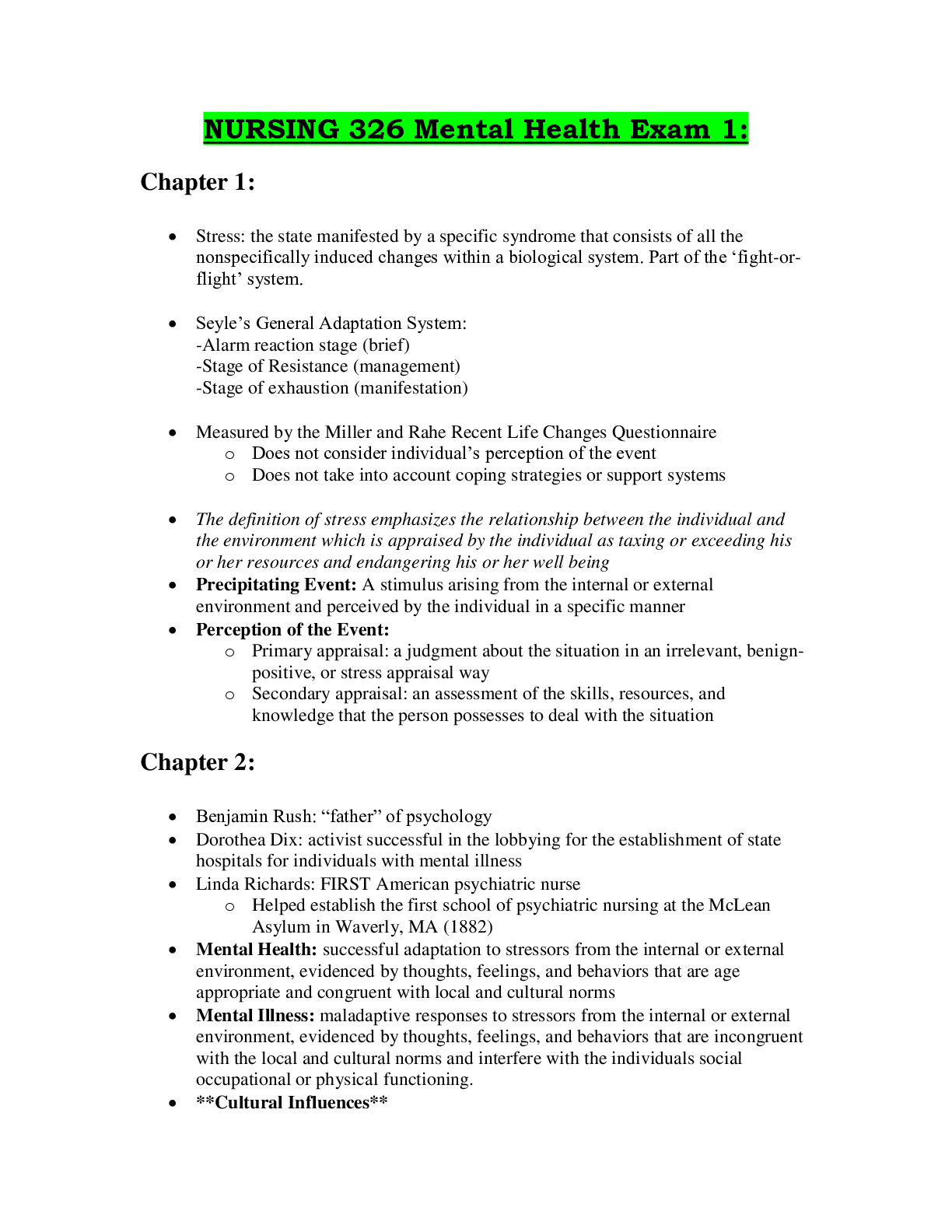
Reviews( 0 )
Document information
Connected school, study & course
About the document
Uploaded On
Mar 18, 2021
Number of pages
5
Written in
Additional information
This document has been written for:
Uploaded
Mar 18, 2021
Downloads
0
Views
28



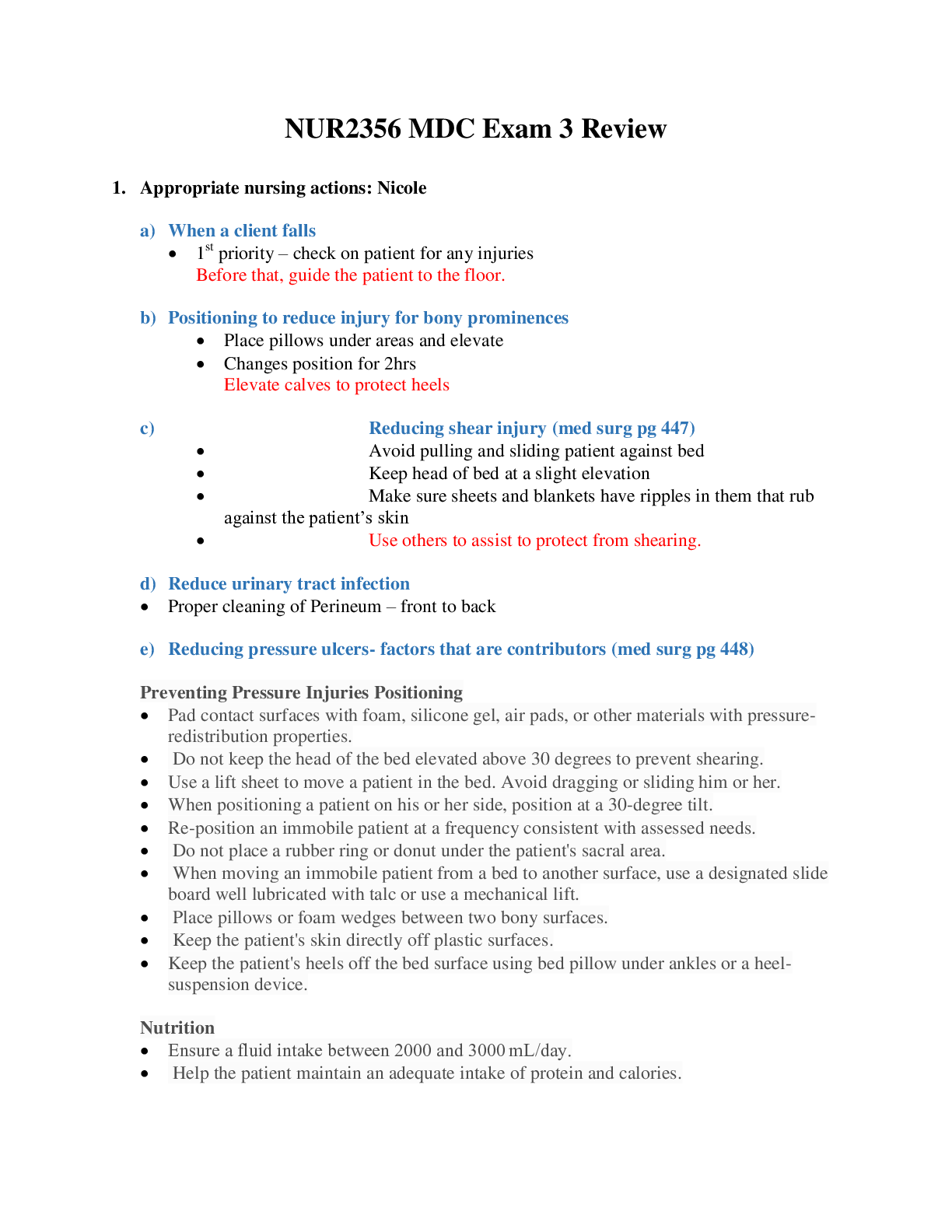
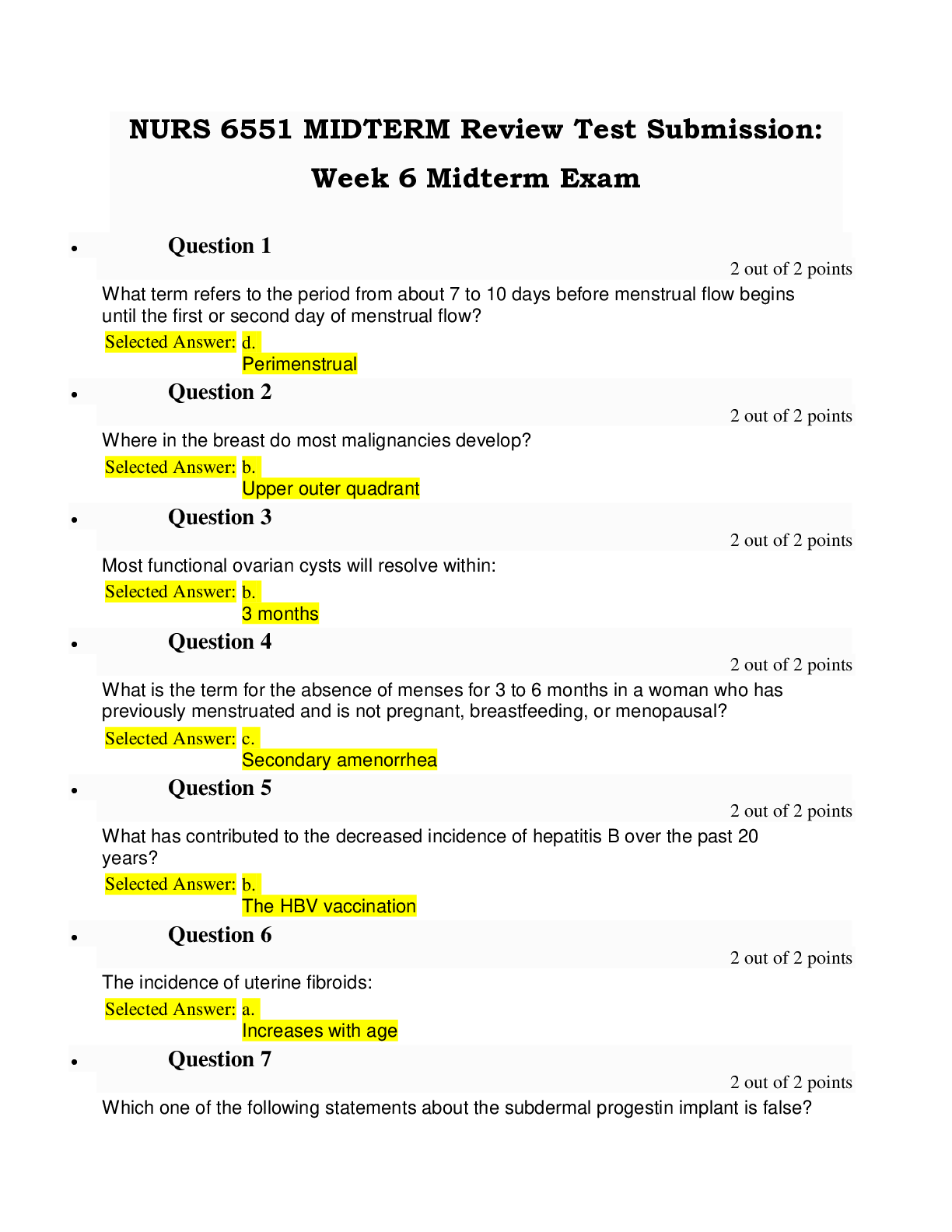





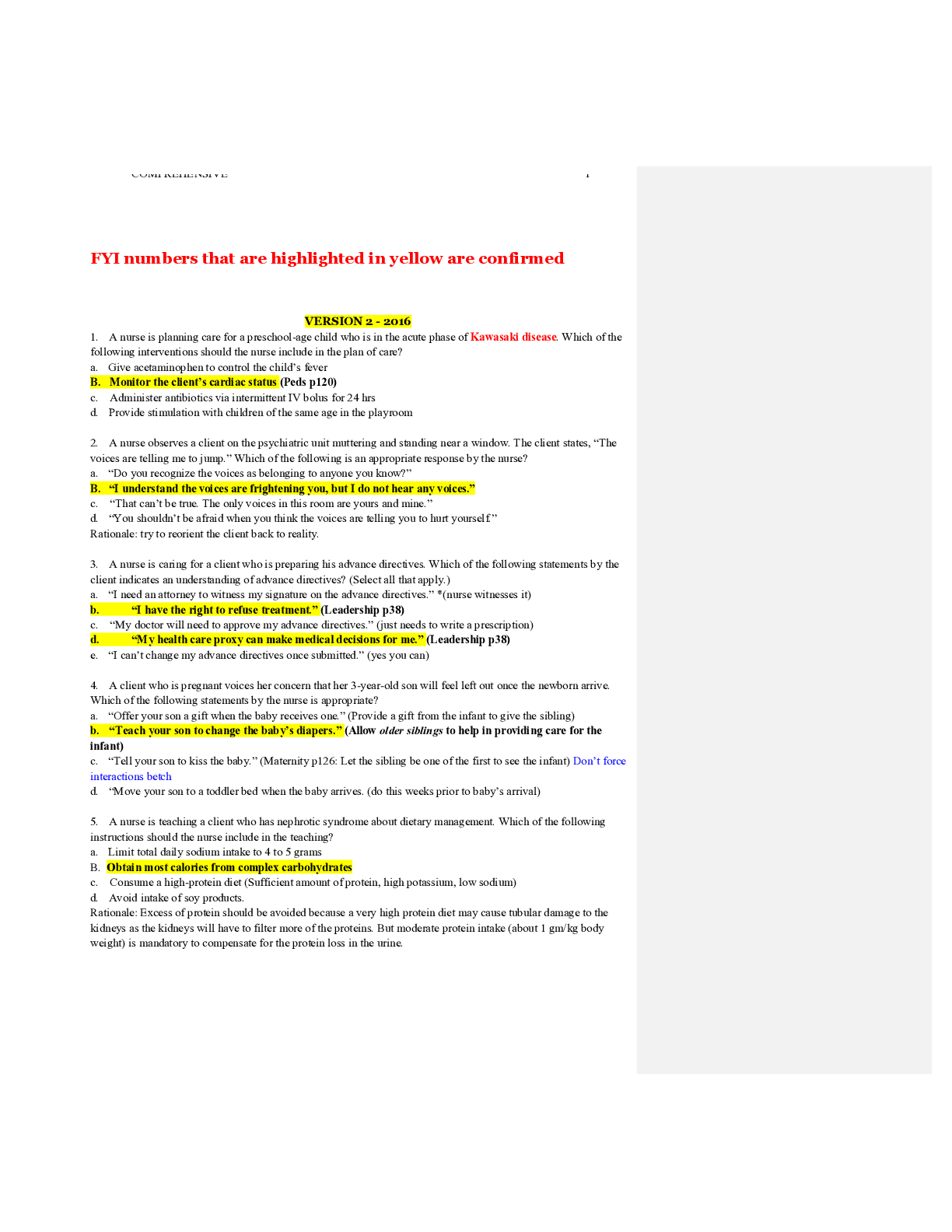
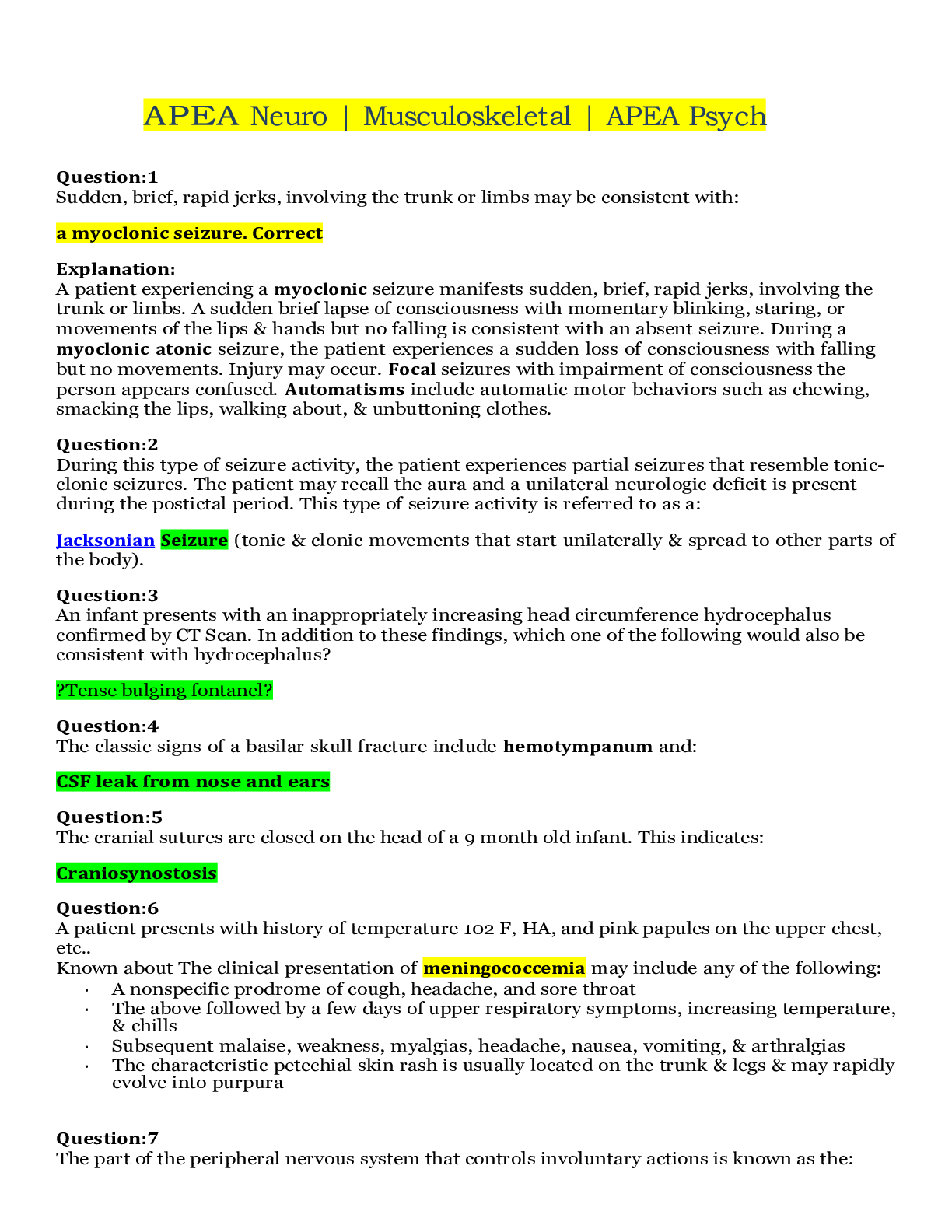
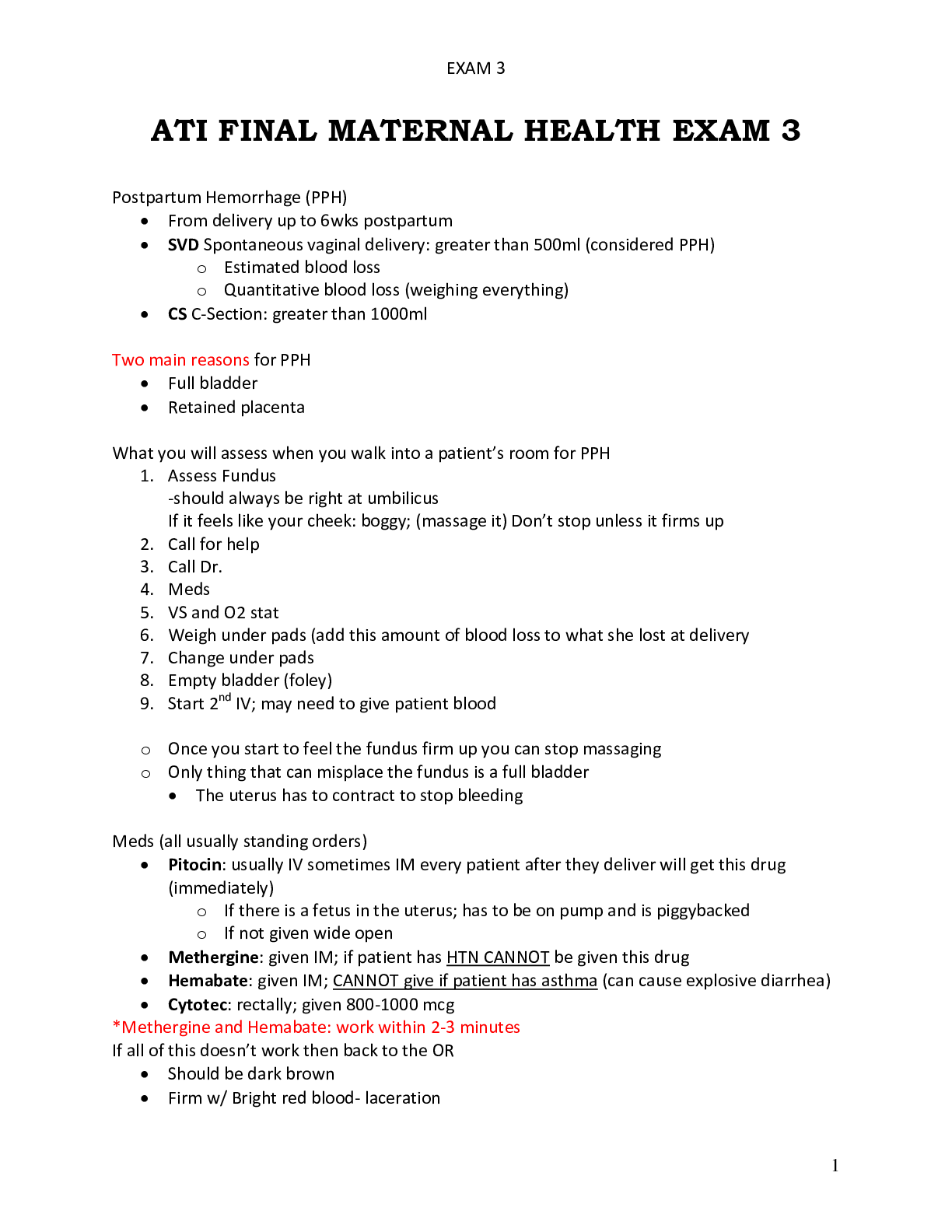
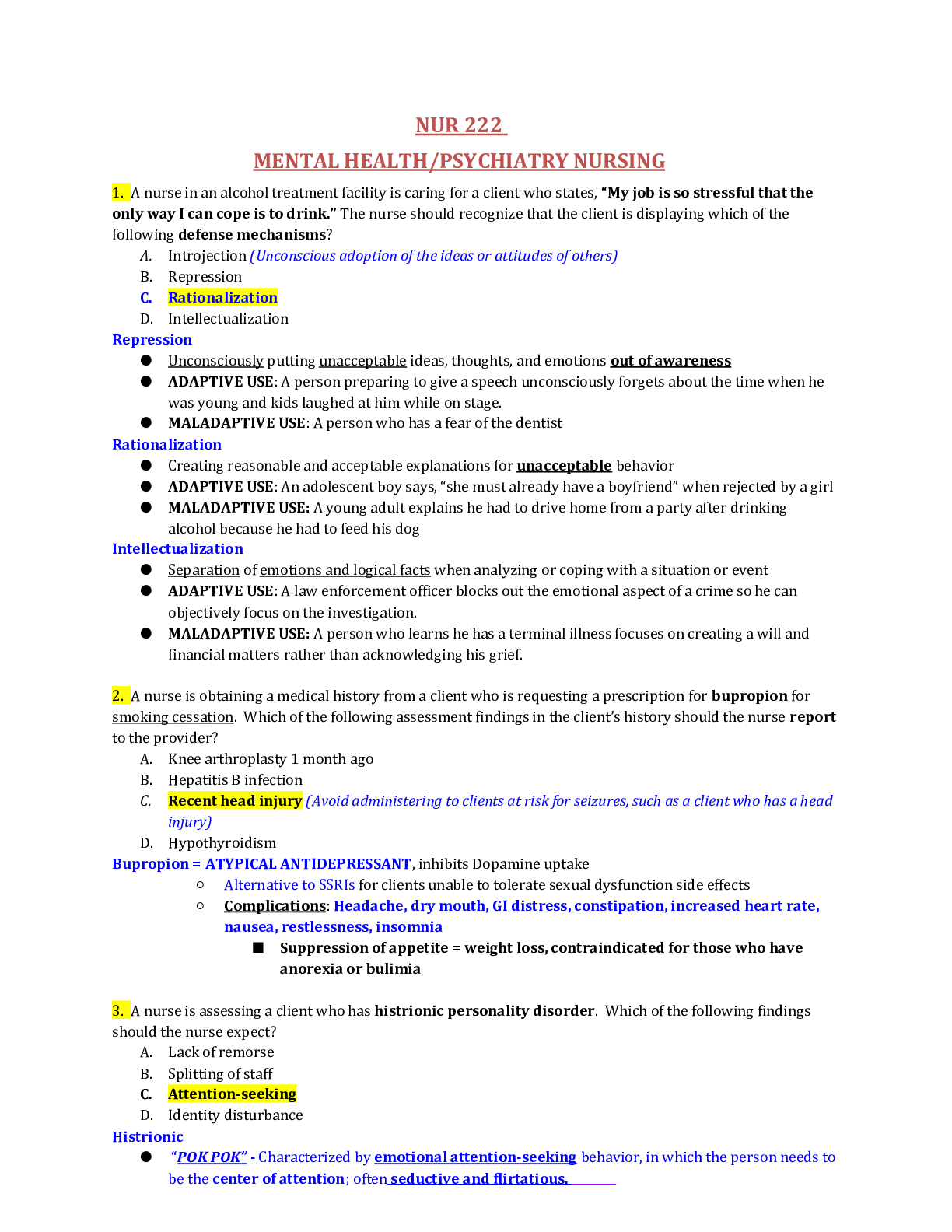

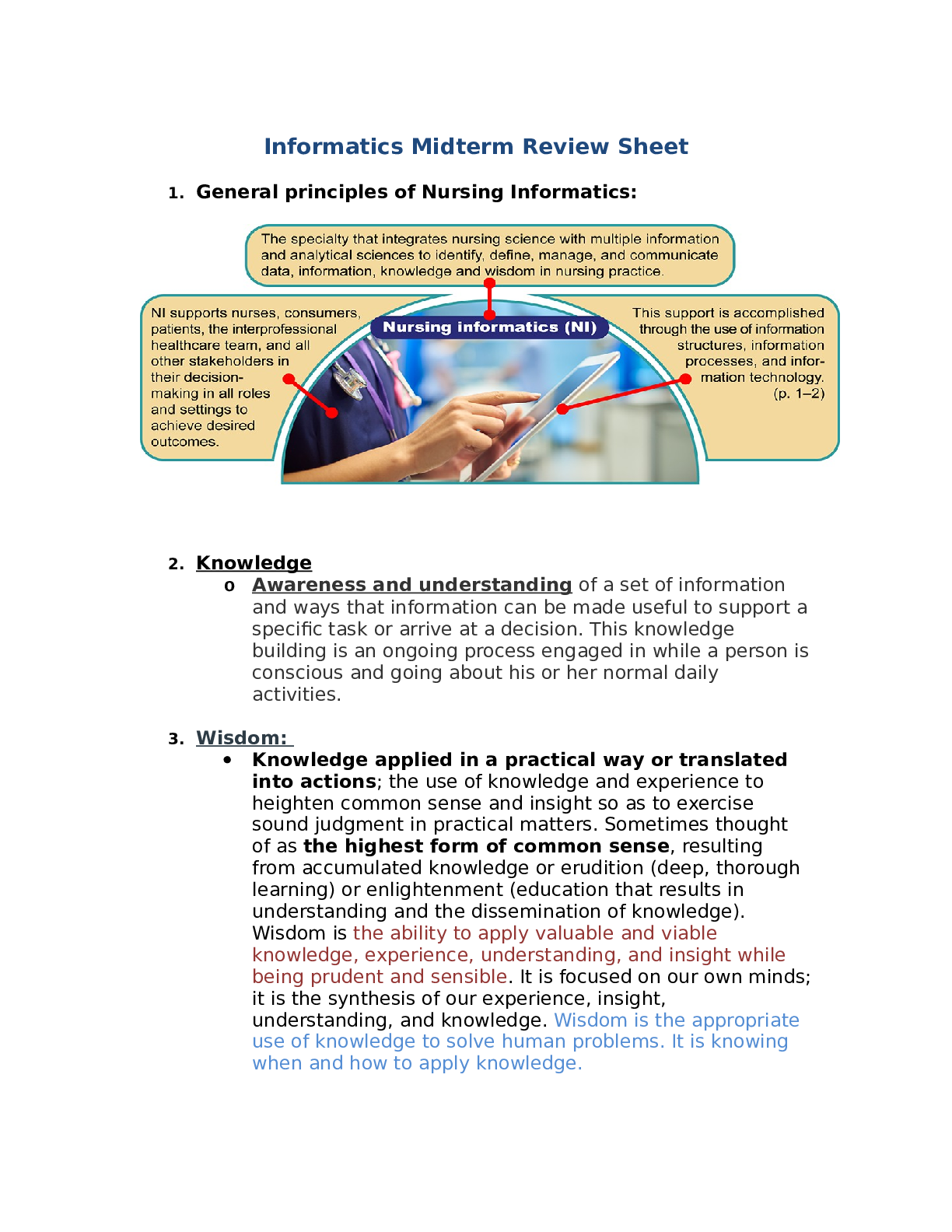
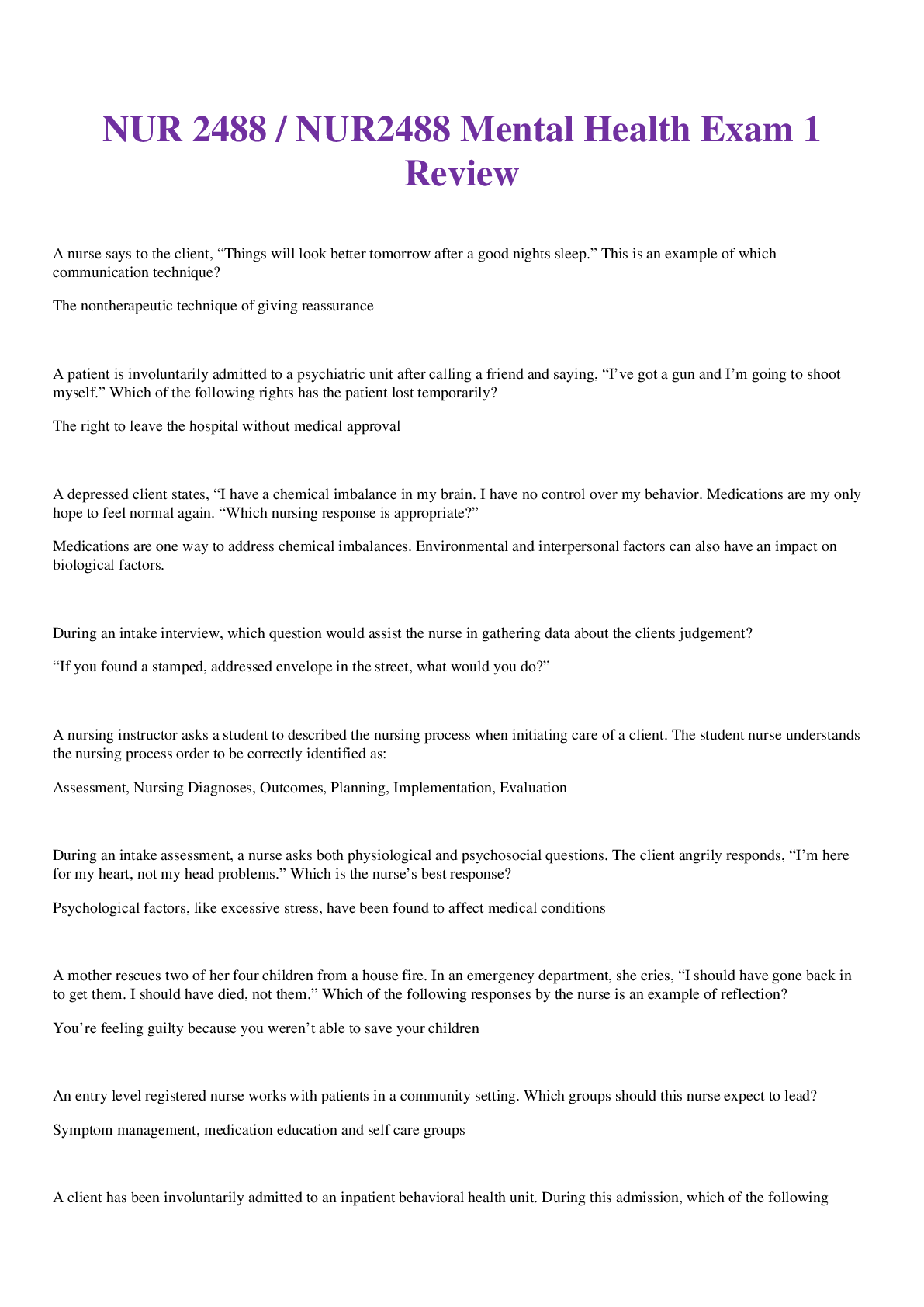
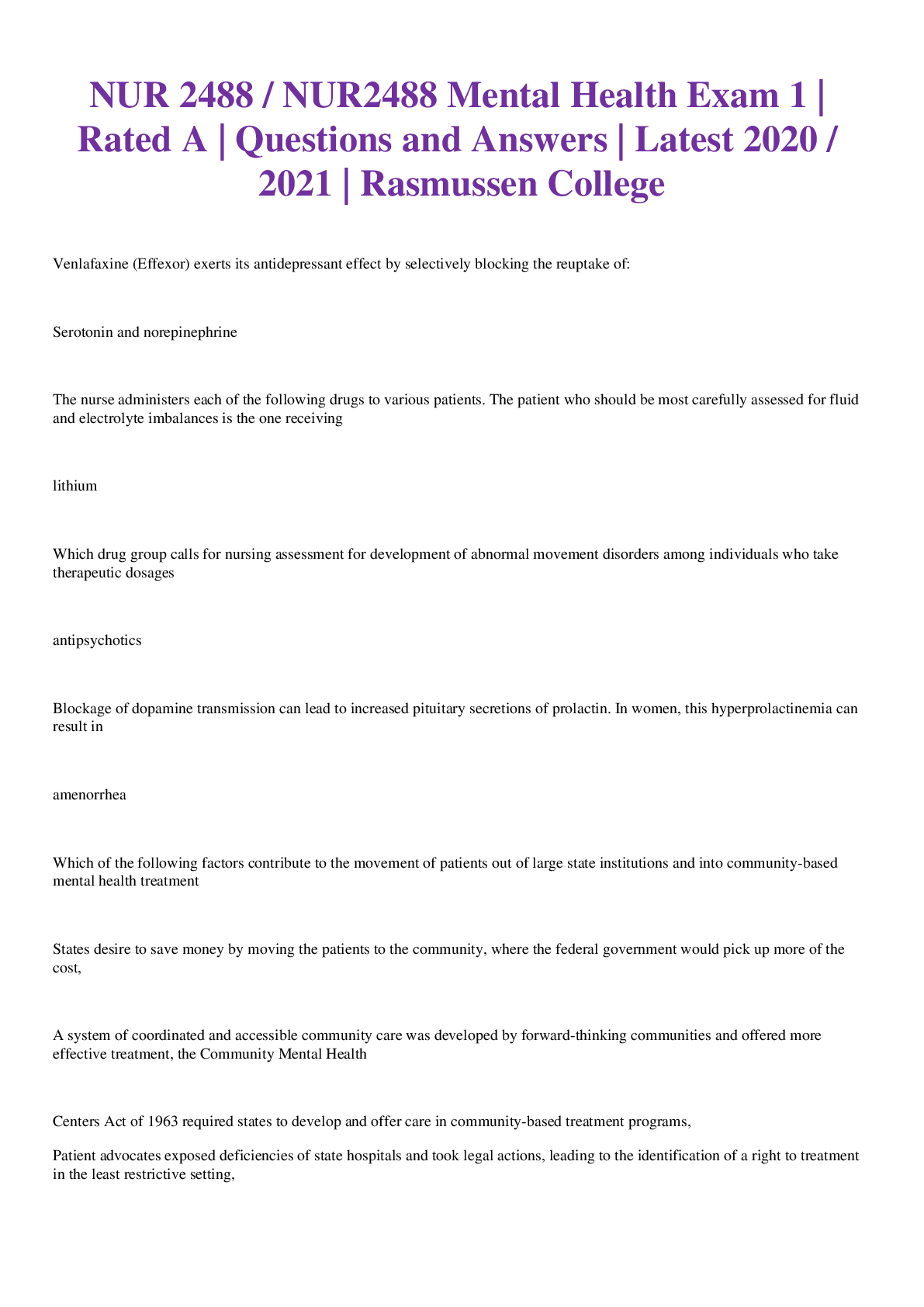
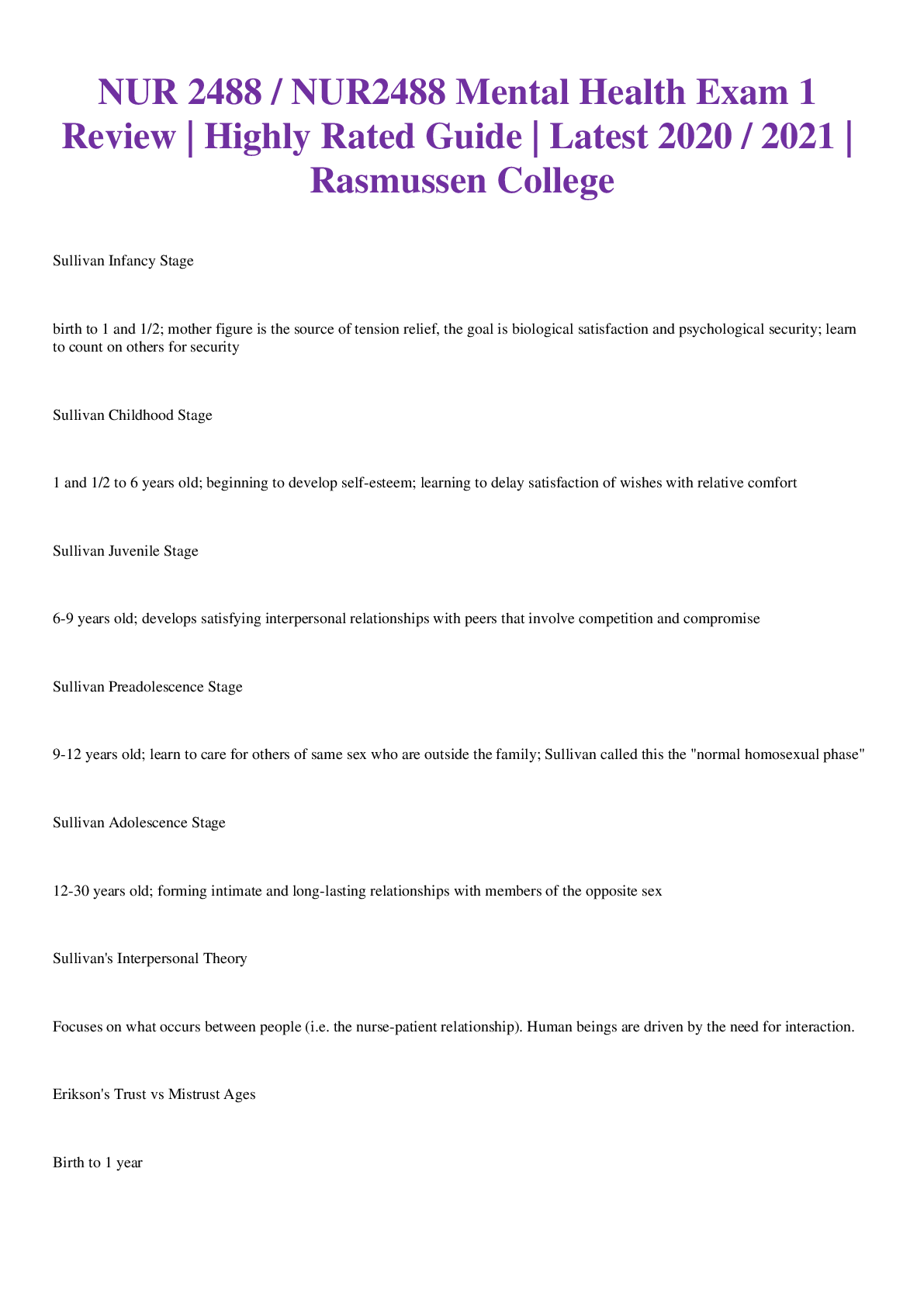

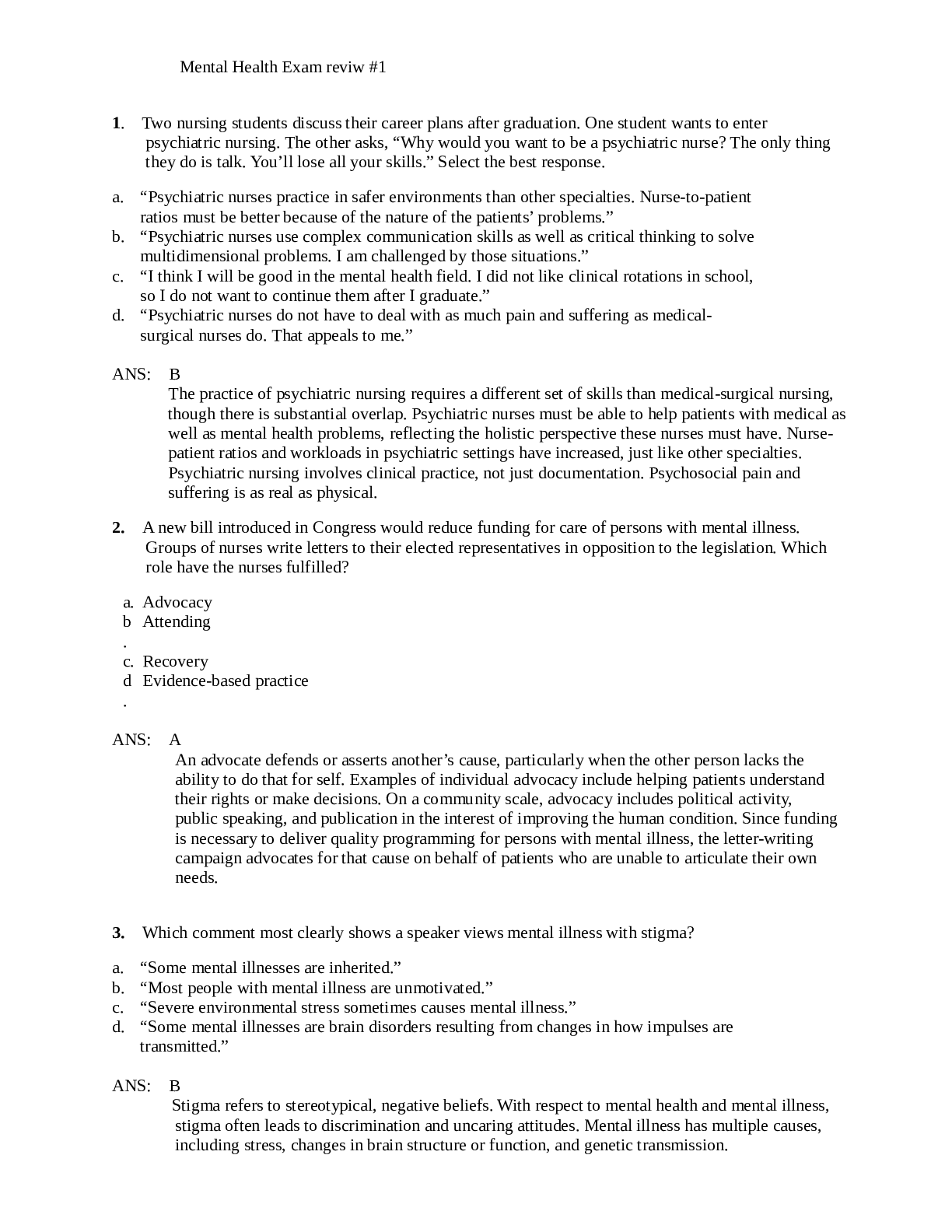
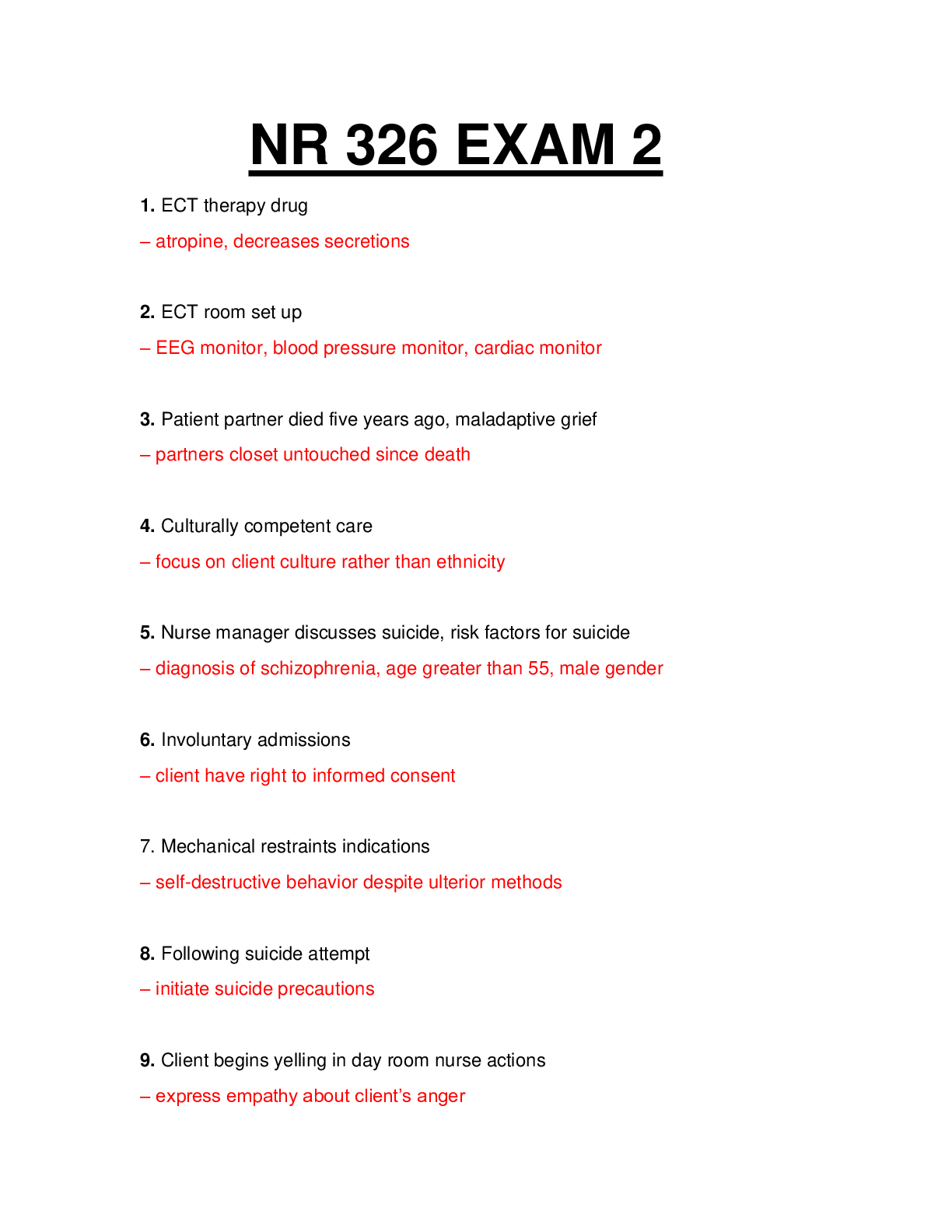
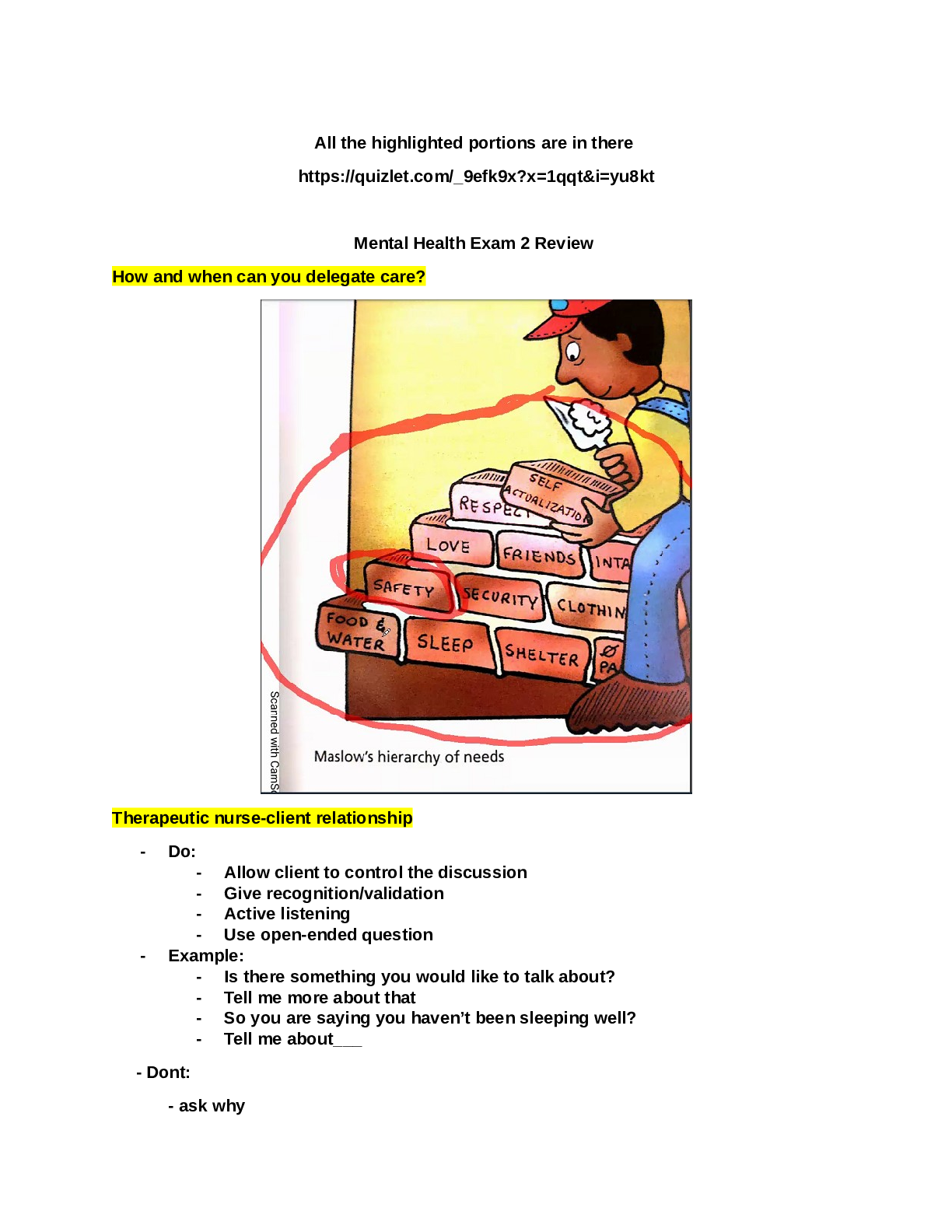
.png)
